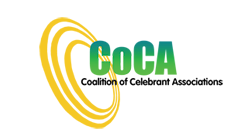Before 2002, the International College of Celebrancy, Monash University and a number of single trainers had offered training in celebrancy.
First Nationally Accredited Course 2002
However, there were a number of short falls with this process.
The Subject Matter Expert Group (SMEG):
- concentrated only on training to be a marriage celebrant, without reference to the 2002 Explanatory Memorandum that explained the intent of the changes, and the government's expectations of the training, which was to cover "knowledge of the Marriage Act 1961 and the Marriage Regulations; ceremony preparation, structure and management skills; knowledge and understanding of family relationships and support services; and office and administrative skills" and "will be based upon such competencies developed by celebrants in 1995 with revision based upon recent consultations with celebrants".
- NOTE: The training and other criteria were seen as a way of regulating the numbers of marriage celebrants. "Department does not expect there to be a flood of celebrants into the market because the conditions for appointment are being raised/increased. All potential celebrants would be required to undertake formal training and all celebrants, existing and new, would be required to undertake ongoing professional development".
- assumed their skills in public speaking, communication, relationship building and community service (i.e. working with community groups), which were requirements for appointment as a marriage celebrant prior to 2002, to be the base line for all adult learners
- assumed also their own prior knowledge and skills, both formally acquired and informally via work and experiences such as knowledge of the history of ceremony including marriage, ceremony stagecraft, literature (poetry and prose), etc. also to be the base line for all adult learners
- assumed that, as they had had little difficulty in understanding and applying the Marriage Act, and conducting weddings, given the new era of "open market" competition that the major skills required of a celebrant would be business skills.
- likewise concentrated only on marriage, and did not consider the broader evolving role of civil celebrants in providing civil namings, renewals and funerals.
- did not prepare a Job Description to outline all the knowledge and skills required of a celebrant that would be needed in the new environment
The Government
- did not foresee the training needs of independent civil celebrants and independent religious celebrants as being different, thus continued to have both included in the same Subdivision C of Commonwealth marriage celebrants
- Note: There had been a number of different sub-groups for certain languages and disabilities as well as civil and religious couples, which under the previous legislation were able to be administered differently, but not so from 2003 when mandatory training for appointment would be required.
- Note: There had been a number of different sub-groups for certain languages and disabilities as well as civil and religious couples, which under the previous legislation were able to be administered differently, but not so from 2003 when mandatory training for appointment would be required.
- did not endorse the full Certificate IV in Marriage Celebrancy for appointment, it was considered religious celebrants would not need "business" units
- only made the one VET Competency Unit, "Plan, conduct and review a marriage ceremony", the baseline training for appointment as a marriage celebrant.
This was the single most critical decision, that created the unexpected (by government) "flood of celebrants into the market"
First Review of Celebrancy Training 2006
At this time CSHISC had a policy of reviewing course very five (5) years and had sufficient government funding to provide an in-depth and broad consultation of the industry and the impact of the new legislation on the training needs of celebrants.All associations and the MLCS were involved in the process and as a result a more suitable broader based course was established for celebrants,
- whether they wished to specialise in marriage work or not, and
- allowing options for the inclusion of business units, but not making those mandatory for either religious or civil celebrants as some civil celebrants had prior business and other expertise, and likewise some religious had prior pastoral care and other expertise that could be assessed under recognised prior learning.
Rona Goold, an AFCC National Committee member, and Robyn Caine, President of the National Council of Celebrant Associations.
Second Review of Celebrancy Training 2012- 2015
In August 2012, the Community Services & Health Industry Skills Council (CSHISC), along with the other 16 Skills Councils under the national Vocational Education and Training (VET), embarked upon a project to streamline courses to remove duplication and overlap wherever possible.
Our celebrancy field .was extremely lucky to have this streamlining project come into play in 2012.
A lot of initial consultation was done by the first CSHISC project officer - with CoCA associations, the AFCC and the MLCS; an initial draft prepared, then with CoCA input the first draft went for public consultation.
Also it was fortunate that the first CSHISC project officer required a Job Description to commence the project. This had not been done for the initial SMEG in 2002 nor for the 2006-2007 review. It was this work that brought to the fore the fact that a Job Descrption mad not been used before and its value in establishing the AQF level.
Work on the qualification was stalled when the Attorney-General's Department refused to endorse a higher qualification, stating that
- "The department does not agree with the way the AQF has been interpreted in the context of the celebrant's role and is confident that a Certificate IV level qualification sufficiently meets the needs of the role of a celebrant"1.
This is despite the fact that the departmental staff are lawyers and administrators, not celebrants of any type, and thus are not qualified nor experienced enough to make a judgement on the broader training needs of celebrants providing a range of ceremonies. - "While marriage celebrants perform their role independently with little supervision or employment, the department provides guidance through telephone and email inquiries, resources specifically developed for use by marriage celebrants - the Guidelines on the Marriage Act for Marriage Celebrants, Advertising Guidelines, Conflict of Interest Guidelines - and through the compulsory professional development activity developed by the department each year." 1
This is an interesting statement that:
- not only shows how limited the department's view of an independent civil marriage celebrant's role, but also the responsibility granted the marriage celebrant under the Act as the responsible person and final decision maker about whether to proceed with marrying a couple or not.
This is evidenced by the statement at the beginning of the Marriage Guidelines Item 1.2 July 2014. "Please remember that the Attorney-‐General’s Department does not provide legal advice to individual marriage celebrantsor members of the public. This department can provide guidance only." - could be viewed as trying to undermine the professional autonomy and responsibilities that grant a training qualification a higher standard, and encouraging dependency upon the department which charges fees for the "guidance" services it provided Commonwealth marriage celebrants.
- not only shows how limited the department's view of an independent civil marriage celebrant's role, but also the responsibility granted the marriage celebrant under the Act as the responsible person and final decision maker about whether to proceed with marrying a couple or not.
On the other hand, celebrancy field has been unlucky to have had:
- changes in CSHISC personnel and Attorney-General Department Marriage Law and Celebrants Section (MLSC) staff. In fact, the latter now has only one person prior to May 2014 in that section.
- the increased perception by the MLCS that marriage celebrants are simply there to provide a predominantly "legal witnessing function" and as such, do not appear to appreciate the fact that the Commonwealth Marriage Celebrant program was established in 1973 to provide personalised wedding civil ceremonies that were meaningful to the couples who sought them because they were designed with the couple to represent their values and needs, and that this program has evolved greatly since its inception.
- NOTE: This independent civil celebrant services are different to the other two subdivisions of Marriage Celebrants who do not personally design ceremonies
- Religious Ceremonies which are determined by the churches or religious groups rites, or
- the Staff Officers/ Registry Office which was to provide a simple registry legal witnessing function.
- a large non-CoCA association view the role of marriage celebrants similarly to the Department, not support the need for training for other ceremonies especially funerals, and not participate actively in contributing to the process of review and refinement of the celebrancy qualification, despite being invited to be a member of the initial SMEG in 2012 and more recently in a re-constituted SMEG in 2014.
Th re-constituted SMEG in 2014 consists of representatives of the following associations:
CoCA associations #
- Australian Marriage Celebrants - AMC
- Association of Civil Marriage Celebrants Victoria - ACMCV
- Alliance of Celebrants Queensland - ACQ
- Celebrants Australia - CAI
- Civil Celebrants Network - CCN
- Civil Celebrants Graduate Association - CCGA
- International College of Celebrancy Association - ICCA
- Coalition of Celebrant Associations - CoCA
Non- CoCA associations
- Funeral Celebrants Australia Association - FCAA
- Australian Federation of Civil Celebrants association - AFCC
1 - AGD feedback CSHISC Review 2013-14 March 2013
Report by Rona Goold CCN Inc Co-Delegate to CoCA, the CoCA representative on the Industry Skills Council Celebrancy Expert Subject Matter Group and the Industry reference group.
March 2015


